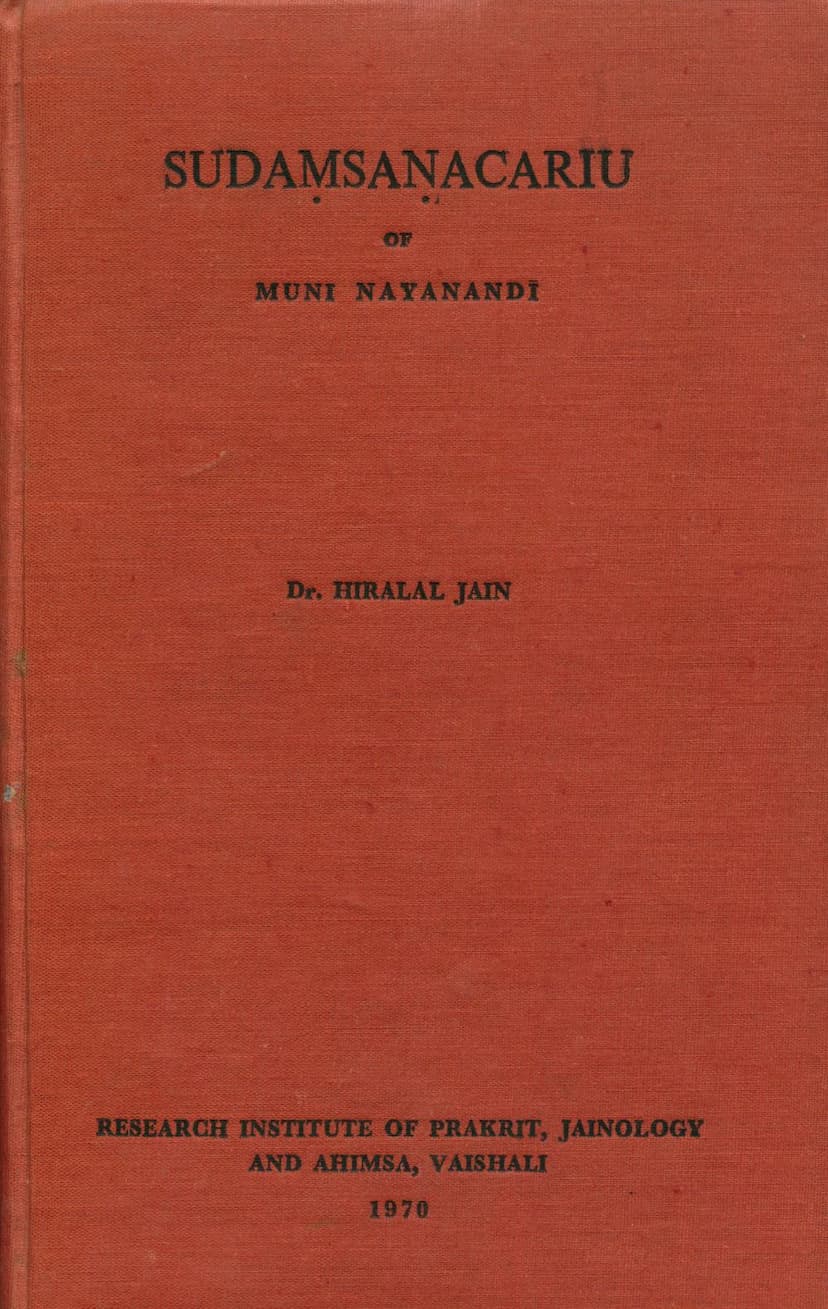Sudansan Chariu
Added to library: September 2, 2025

Summary
Here is a comprehensive summary of the Jain text "Sudansan Chariu" by Muni Nayanandi, based on the provided information:
Book Title: Sudansan Chariu (also spelled Sudamsanacariu) Author: Muni Nayanandi Editor/Publisher: Dr. Hiralal Jain, Research Institute of Prakrit, Jainology and Ahimsa, Vaishali Publication Year: 1970 Catalog Link: https://jainqq.org/explore/032196/1
Overall Summary:
"Sudansan Chariu" is a Jain narrative poem composed in the Apabhramsa language by Muni Nayanandi. The text, critically edited and translated into Hindi by Dr. Hiralal Jain, aims to showcase the auspicious results of practicing Dharma (righteousness) according to Jain principles. The story revolves around the protagonist Sudarshan, whose life journey demonstrates the power of the Pancha Namaskar mantra and adherence to Jain ethics.
Key Themes and Content:
-
The Power of the Pancha Namaskar Mantra: The central theme of the "Sudansan Chariu" is the extraordinary efficacy of chanting the Pancha Namaskar mantra. The narrative begins by illustrating how even a simple cowherd, through his devotion to this mantra, is reborn as the wealthy merchant Sudarshan and ultimately achieves liberation (moksha).
-
The Protagonist's Life (Sudarshan):
- Rebirth: The story details Sudarshan's previous life as Subhaga, a cowherd, who diligently chanted the Pancha Namaskar mantra. His first life as a wealthy merchant, Rishabhdas, and his wife Arhaddasi, also highlights his devotion.
- Virtuous Living: Despite being reborn into a prosperous life, Sudarshan remains untempted by passions and desires, guided by his innate virtue and the power of the mantra.
- Love and Marriage: The narrative depicts Sudarshan's love and marriage with Manoroma, a beautiful and virtuous maiden.
- Challenges and Trials: Sudarshan faces several significant trials:
- Temptation: He is tempted by Kapila, his friend's wife, but remains steadfast in his vows.
- Rani Abhaya's Misconduct: Queen Abhaya, lusting after Sudarshan, conspires with her maid Pandita to frame him. Pandita devises a clever plan involving clay figures and manipulates the palace guards to create a false accusation of attempted violation of the queen's chastity.
- False Accusation and Capital Punishment: Based on the false accusation, the king unjustly orders Sudarshan's execution.
- Divine Intervention: Just as he is about to be executed, a Vyantar (a class of celestial beings) intervenes, saving him and revealing the truth.
- Renunciation and Renowned Virtues: Freed from the crisis, Sudarshan renounces the world, realizing the transient nature of worldly existence, and embraces asceticism (munideeksha). He rigorously practices the Jain vows.
- Previous Lives: Through the grace of a sage, Sudarshan learns about his past lives: a tiger, a dog, and finally Subhaga the cowherd. This knowledge further strengthens his resolve.
- Attaining Kevala Jnana and Moksha: After a life of strict asceticism, Sudarshan destroys his remaining karma, attains Kevala Jnana (omniscience), and ultimately achieves liberation (Siddhatva).
-
Literary Style and Structure:
- Genre: The "Sudansan Chariu" is a Charita Kavya (biographical poem).
- Structure: It is divided into twelve Sandhis (sections), with each Sandhi further broken down into Kadavakas (stanzas or verses).
- Language: The language is Apabhramsa, characterized by its rich use of alliteration, complex Sanskrit compounds, and intricate use of figures of speech, reminiscent of poets like Bana and Subandhu. It also incorporates vernacular elements and proverbs to add naturalness and charm.
- Poetic Devices: The work is rich in rhetorical devices (alankaras), including similes, metaphors, and hyperbole, which are often based on wordplay (shlesha). The descriptions, particularly of landscapes, cities, seasons, and festivals, are vivid and elaborate.
- Metre: A notable feature is the diversity of metres (chhandas) used, contributing to the poem's literary quality. The editor, Dr. Hiralal Jain, has provided a detailed analysis of these metres.
-
Historical and Literary Context:
- Author's Timeline: The author, Nayanandi Muni, is placed around the 11th century Vikram Samvat (approximately 1043 AD), as indicated by the mention of King Bhojadeva in Dhara Nagari, whose reign is dated around 1020-1047 AD.
- Influence: The narrative structure and themes of "Sudansan Chariu" have clear parallels with earlier Jain narratives and broader Indian literary traditions dealing with themes of love, betrayal, divine intervention, and the pursuit of spiritual liberation. The preface draws attention to similar tales in Sanskrit, Prakrit, and Pali literature.
- Manuscript Tradition: The critical edition is based on four ancient handwritten manuscripts, sourced from the Shastrabhandars of Mahavirji (Ka, Kha) and other collections. These manuscripts provide textual variations useful for scholarly study.
Significance:
"Sudansan Chariu" is significant for its contribution to Apabhramsa literature, its detailed depiction of Jain philosophy and practices, its intricate poetic artistry, and its role in tracing the lineage of Jain narrative traditions. The inclusion of a Hindi translation and Sanskrit commentary by Dr. Hiralal Jain makes the text accessible to a wider audience of scholars and enthusiasts. The publication by the Research Institute of Prakrit, Jainology and Ahimsa underscores its importance in preserving and promoting ancient Indian learning.